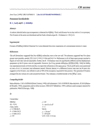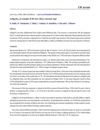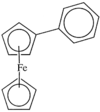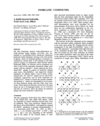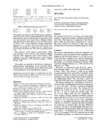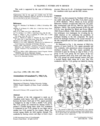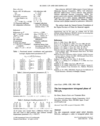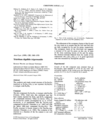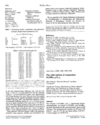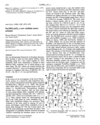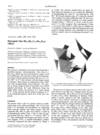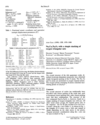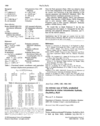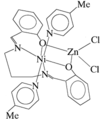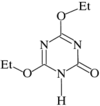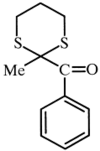issue contents
December 1999 issue

Cover illustration: Pseudosymmetry with Z' = 4 in 1,3-propanesultone at 100 K, see Billodeaux, Owens, Sayes, Soper & Fronczek, pages 2126-2129. The unit cell of the title compound with H atoms omitted.
cif-access (inorganic compounds)
Download citation


Download citation


A sodium chloride lattice-type arrangement is obtained for K[BH4]. The K and B atoms lie on sites with m3m symmetry. The H atoms of the anion are disordered and the freely refined unique B—H distance is 1.09 (1) Å.
Download citation


Download citation


LaMg2Ni9, the first member of the AB2C9 structure type, related to the PuNi3 structure, has been refined from single-crystal diffraction data.
cif-access (metal-organic compounds)
Download citation


Download citation


The crystal structure of phenylferrocene shows the two cyclopentadienyl (Cp) rings to be parallel to each other and almost eclipsed. The pendant phenyl ring is bonded at a C—C distance of 1.469 (5) Å and the angle between the mean planes of the Cp and phenyl rings is 11.4 (3)°.
Download citation


Download citation


In the centrosymmetric complex dimer, the two independent Sn atoms are five-coordinate in C2SnO3 geometries [C—Snendocyclic—C 140.9 (5)° and C—Snexocyclic—C 139.9 (4)°]. Owing to an Sn⋯O interaction of 2.779 (6) Å, the geometry of the Snendocyclic atoms is distorted towards skew-trapezoidal bipyramidal.
Download citation


Download citation


Green [Cu(NO2)2(phen)] contains six-coordinate copper(II) with a distorted tetragonal [CuIIN2O4] core. The nitrito ligands are bonded to copper using both O atoms [Cu—O 1.999(3) and 2.056 (2) Å, and longer Cu—O 2.470 (3) and 2.396 (3) Å]. The Cu—N distances are 1.995 (3) and 2.021 (2) Å.
Download citation


Download citation


Reaction of (MeC5H4)2YbCl with LiNC5H10 in toluene affords the neutral title complex, (MeC5H4)2Yb(NC5H10)(HNC5H10). The Yb atom is coordinated by two methylcyclopentadienyl rings and two piperidine/piperidinide N atoms to form a distorted tetrahedral geometry.
Download citation


Download citation


The copper coordination in the title complex is fundamentally tetragonal, but there are two weak Cu—Cl contacts along the z axis. Thus, the coordination can also be considered as distorted octahedral. Through these contacts, the complex forms a one-dimensional chain structure with Cu⋯Cu distances of 4.117 (2) and 4.175 (2) Å.
Download citation


Download citation


In the title complex, the N atoms of the 4,4'-di-tert-butyl-2,2'-bipyridine and azide ligands form a distorted octahedron around the MnII atom, with the two azide moieties in a cis configuration.
Download citation


Download citation


The title compound is an example of a crystallographically characterized dirhenium complex. The two independent but similar molecules show Re—Re distances of 2.5160 (3) and 2.5166 (3) Å.
Download citation


Download citation


The CuII ion is six-coordinated in a distorted octahedral environment with bonds to the four N atoms of the tetraamine ligand and two O atoms of the perchlorate ion. The tetradentate ligand is in its stable conformation with the three six-membered rings in chair forms.
cif-access (organic compounds)
Download citation


Download citation


The crystal structure is different from those of all other dipeptides with two hydrophobic residues. There are thick hydrophobic layers generated by Leu side chains. Solvent water molecules, located on twofold axes, link charged N- and C-terminal groups in pairs of hydrophilic sheets.
Download citation


Download citation


The title compound has bond lengths which indicate very little delocalization of electronic charge in the pyrimidine ring. Molecules in the structure are linked to form chains in the a direction by C—H⋯O hydrogen bonds [C⋯O 3.196 (2) Å].
Download citation


Download citation


There are two independent cations and anions in the title compound. The anions are linked by N—H⋯O hydrogen bonds to form infinite chains and the cations are linked to these chains by N—H⋯N hydrogen bonds.
Download citation


Download citation


The conformation and packing of the title compound are determined by N—H⋯O intermolecular hydrogen bonds and C—H⋯O contacts. The two rings of the pteridine moiety are individually essentially planar and are inclined at 4.3 (3)° with respect to one another.
Download citation


Download citation


The relative orientations of the pyrimidine base and pyranoside sugar moieties in C19H26N4O11.H2O, (I), and C23H30N3O13, (II), are primarily determined by intramolecular N—H⋯O and O—H⋯O hydrogen bonds in (I), and by an N—H⋯O hydrogen bond in (II).
Download citation


Download citation


The molecular structures of the 3-aryl-5-cyanopyrazolo[3,4-b]pyridines 2C26H19ClN4.C3H7NO, (I), and C26H20N4O, (II), exist in the 2H tautomeric form both in solution and in the crystalline state. The C25H14Cl2N4 compound, (III), is shown to be the aromatic crystalline oxidation product of a 2H precursor in solution.
Download citation


Download citation


The structures of 4-methylpyridinium chloride, C6H8N+.Cl−, (I), 3-methylpyridinium chloride, C6H8N+.Cl−, (II), and 3-methylpyridinium bromide, C6H8N+.Br−, (III), have been determined. In all three cases, there is a hydrogen bond between the halogen atom and the protonated N atom. Furthermore, the packing is stabilized by several C—H⋯halogen contacts. It is remarkable that neither (II) and (III), nor (I) and 4-methylpyridine hydrobromide are isostructural.
Download citation


Download citation


The title compound is a cycloaddition product of p-nitrobenzadoxime and N-phenyl-3-tolyolene-4-isoquinolone. It contains an almost planar isoxazoline ring. The C atoms of the isoquinoline moiety lie in a common plane, with the N atom deviating by 0.474 (2) Å from that plane.
Download citation


Download citation


The title compound belongs to the class of styrylquinolines which are of interest because of their photochemical behaviour. The central double bond is trans configured and the two quinoline rings form similar angles with the plane of the double bond.
Download citation


Download citation


The title compound is a nearly planar molecule. The crystal packing is stabilized by intermolecular C—H⋯O hydrogen bonds.
Download citation


Download citation


The asymmetric unit contains two independent molecules which are linked by a pair of N—H⋯O hydrogen bonds [N⋯O 2.852 (4) and 2.914 (4) Å]. The two molecules exhibit significant differences in conformation; in one molecule, the 2-azidoethyl groups are far from the shielding area of the α-benzene ring and almost vertical to it, while in the other molecule these two β-azidoethyl groups are close to the plane of the α-benzene ring and approximately parallel to it.
Download citation


Download citation


The title compound is a multi-functional compound and potential intermediate for making new molecular entities. The three substituents other than methyl have essentially planar skeletons, each of which is approximately perpendicular to the hexasubstituted aromatic ring.
Download citation


Download citation


Celecoxib {4-[5-(4-methylphenyl)-3-trifluoromethyl-1H-pyrazol-1-yl]benezenesulfonamide} is one of the selective COX-II inhibitors with anti-inflammatory activity. The molecules are connected into a chain by an intermolecular hydrogen bond between the N and O atoms of sulfonamide groups in neighbouring molecules.
Download citation


Download citation


The title compound, 8-methoxy-1,3-dimethyl-12-thioxopyrido[1',2':3,4]-imidazo[1,2-a][1,3]benzimidazol-2(12H)-one, was isolated during impurity profiling of omeprazole and was crystallized from ethanol. The molecules are essentially planar and show normal van der Waals interactions.
inorganic compounds
Download citation


Download citation


The structure of 3CaO.Al2O3.CaI2.10H2O, also formulated as Ca2Al(OH)6I.2H2O, consists of positively charged main layers, [Ca2Al(OH)6]+, and negatively charged interlayers, [I−,2H2O]. The oxygen coordination numbers of the Al3+ and Ca2+ cations are six and seven, respectively, and all non-H atoms occupy ordered sites.
Download citation


Download citation


The structure of KCu2VSe4 consists of a network of edge- and corner-sharing [VSe4] and [CuSe4] tetrahedra parallel to (010). The layers are separated by K+ cations.
Download citation


Download citation


The structure of NH4V3O8 consists of vanadium oxide layers and NH4+ cations held together via N—H⋯O hydrogen bonds.
Download citation


Download citation


A normal spinel nickel chromite undergoes a cubic to tetragonal phase transition at low temperature. The structure of the tetragonal phase has been refined using single-crystal X-ray diffraction data.
Download citation


Download citation


The title complex is a rare example of a discrete molecular cyano-copper-nickel complex.
Download citation


Download citation


The single-crystal structure determination of Er3Ga2Ge3 (analysed as Er3Ga2.21Ge2.79) is reported. Er3Ga2Ge3 is isotypic with Pu3Pd5.
Download citation


Download citation


The crystal structure refinement of the solid solution of composition K2PdBr2.24Cl1.76, dipotassium bromochloropalladate, which is an isotype of both potassium tetrachloropalladate(II) and potassium tetrabromopalladate(II), is reported.
Download citation


Download citation


The structure of disodium dioxoniobium arsenate is built of NbO6 octahedra and AsO4 tetrahedra sharing corners to form layers. The Na+ cations are located between the layers.
Download citation


Download citation


The structure of rubidium tetracontaoxo(hydro)(dodecamolybdo)vanadate tetradecahydrate is built up of heteropolyoxy anions with the general formula XM12O40 (X = VV and M = MoVI or VIV) that conform with the Keggin family of structures.
Download citation


Download citation


The Ba3TaAs3O orthorhombic cell contains pseudo-tetrahedral TaAs3O6− anions surrounded by Ba2+ cations. This forms a three-dimensional network of interconnected trigonal prisms.
Download citation


Download citation


Na2Ca3Ta2O9 exhibits R32 symmetry and contains [Ta2O9]8− face-sharing trigonal prisms. Na and Ca atoms also occupy oxygen trigonal prism sites.
Download citation


Download citation


Trizinc tris[trioxoselenate(IV)] hydrate, Zn3(SeO3)3.H2O, is built up from a dense network of ZnO6 octahedra and SeO3 pyramids, sharing vertices and edges. One of the zinc octahedra is exceptionally distorted with two of its Zn—O bonds longer than 2.48 Å.
metal-organic compounds
Download citation


Download citation


Download citation


Download citation


Download citation


Download citation


Download citation


Download citation


Download citation


Download citation


Download citation


Download citation


Download citation


Download citation


Download citation


Download citation


Download citation


Download citation


Download citation


Download citation


Download citation


Download citation


Download citation


Download citation


Download citation


Download citation


Download citation


Download citation


Download citation


Download citation


Download citation


Download citation


Download citation


Download citation


Download citation


Download citation


Download citation


Download citation


Download citation


Download citation


Download citation


Download citation


Download citation


Download citation


Download citation


Download citation


Download citation


Download citation


Download citation


Download citation


Download citation


Download citation


Download citation


Download citation


Download citation


Download citation


Download citation


Download citation


Download citation


Download citation


Download citation


Download citation


Download citation


Download citation


Download citation


Download citation


Download citation


Download citation


Download citation


Download citation


Download citation


Download citation


Download citation


Download citation


Download citation


Download citation


Download citation


Download citation


Download citation


Download citation


Download citation


Download citation


Download citation


Download citation


organic compounds
Download citation


Download citation


Download citation


Download citation


Download citation


Download citation


Download citation


Download citation


Download citation


Download citation


Download citation


Download citation


Download citation


Download citation


Download citation


Download citation


Download citation


Download citation


Download citation


Download citation


Download citation


Download citation


Download citation


Download citation


Download citation


Download citation


Download citation


Download citation


Download citation


Download citation


Download citation


Download citation


Download citation


Download citation


Download citation


Download citation


Download citation


Download citation


Download citation


Download citation


Download citation


Download citation


Download citation


Download citation


Download citation


Download citation


Download citation


Download citation


Download citation


Download citation


Download citation


Download citation


Download citation


Download citation


Download citation


Download citation


Download citation


Download citation


Download citation


Download citation


Download citation


Download citation


Download citation


Download citation


Download citation


Download citation


Download citation


Download citation


Download citation


Download citation


Download citation


Download citation


Download citation


Download citation


Download citation


Download citation


Download citation


Download citation


Download citation


Download citation


Download citation


Download citation


Download citation


Download citation


Download citation


Download citation


Download citation


Download citation


Download citation


Download citation


international union of crystallography
Free 



 journal menu
journal menu











